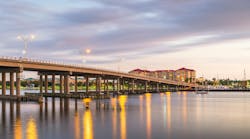The replacement of one of the oldest floating bridges in the world received a boost of acceleration this spring from the Washington State Department of Transportation and the Accelerated Construction Technology Transfer (ACTT) team sponsored by the Federal Highway Administration (FHWA) and the American Association of State Highway & Transportation Officials (AASHTO).
Washington State Rte. 520 is one of only two major state highways running from east to west between Seattle on the west side of Lake Washington and the communities of Bellevue, Redmond and Kirkland on the east side of the lake.
Designed for an average daily traffic of 65,000 vehicles, this primary artery now carries between 110,000 and 120,000 vehicles, with congestion lasting up to 13 hours on weekdays.
In addition, the highway’s 40-year-old Evergreen Point floating bridge across Lake Washington is reaching the end of its useful life. The bridge is vulnerable to storms and seismic events, with its pontoons subject to cracking and leaking. The bridge’s low position in the water also makes it susceptible to high waves during storms.
The total cost of the project, including replacement of the bridge, is estimated to range between $1.5 and $3.4 billion, depending on the alternative selected. Three project alternatives—a four-lane, six-lane and eight-lane bridge—are currently being evaluated by WSDOT.
The March 2004 ACTT workshop in Seattle brought together local and national transportation experts from state highway agencies, industry, academia and FHWA to address the many challenges of this complicated urban project.
The skill areas represented included design, construction, structures, traffic/safety/intelligent transportation systems, innovative contracting and financing, environment and right-of-way. The goals of the workshop included:
- Shorten project construction time;
- Minimize construction impacts;
- Identify options for construction staging;
- Develop creative financing strategies;
- Maximize maintenance of traffic flow; and
- Encourage contractor innovation and involvement.
Recommendations for meeting these goals included such innovations as using self-consolidating concrete (SCC), particularly for the construction of the bridge’s pontoons. SCC flows easily and can completely fill intricate and complex forms under its own weight, eliminating the need for vibration. Using conventional concrete, in contrast, would be much more labor intensive.
Other recommendations included accelerating the project through the use of prefabricated bridge construction, including precast substructures, deck panels and superstructures, and using a design-build contract to shorten the project delivery time by overlapping design with construction.
Also suggested was designing the bridge’s simple pontoons first so that they can be constructed while the more complex pontoons are still being designed, and breaking pontoon fabrication into separate contracts, depending on type.
In the area of financing, various options, including tolls and sale of bonds, were discussed.
The recommendations presented at the workshop could potentially reduce construction time by as much as one-third, shaving 1-2 years off the project, while minimizing construction-related congestion and improving safety. Depending on the availability of funds, WSDOT tentatively plans to begin construction on the new bridge in 2008.
For more information about the SR 520 Bridge Replacement Project, visit www.wsdot.wa.gov/projects/SR520Bridge. More information on ACTT, including the new ACTT Interim Report highlighting the initiative’s activities and accomplishments to date, can be found at www.fhwa.dot.gov/construction/accelerated.
To date, 11 ACTT workshops have been successfully completed. Future scheduled workshops include ones in Wyoming (September), Rhode Island (October), New Jersey (November) and Nevada (March 2005).

